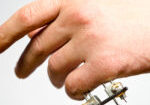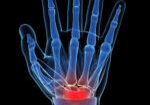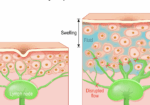Outcomes of Rigid Night Splinting and Activity Modification in the Treatment of Cubital Tunnel Syndrome
Filed under Treatments
Shah, C. M., Calfee, R. P., Gelberman, R. H., & Goldfarb, C. A. (2013). Outcomes of rigid night splinting and activity modification in the treatment of cubital tunnel syndrome (night splint for cubital tunnel syndrome). The Journal of Hand Surgery, 38(6), 1125–1130.e1. https://doi.org/10.1016/j.jhsa.2013.02.039
By: Sophia Grimm
The Skinny:
The purpose of this study was to identify symptom improvement in patients with mild to moderate cubital tunnel syndrome treated with rigid night orthosis and activity modifications. The degree of ulnar nerve dysfunction was identified according to Dellon’s classification.
- Dellon 1: Limited to intermittent paresthesia and weakness
- Dellon 2: Intermittent paresthesia and notable weakness
- Dellon 3 Persistent paresthesia and significant weakness with or without intrinsic muscular atrophy
Current conservative treatment guidelines for cubital tunnel syndrome are nerve gliding exercises, activity modification, and orthotic use. It is also common to use the cubital tunnel syndrome splint.
In the Weeds:
This study included 19 patients with Dellon’s 1 & 2 classification of cubital tunnel syndrome. All patients were treated with a rigid nighttime orthosis holding the elbow at a position of 45 degrees of flexion for 3 months and activity modifications to decrease irritation of the ulnar nerve. Patients were evaluated at enrollment, 6 weeks, 3 months, and 1 year with the QuickDASH, SF-12, grip and pinch strength measurement, presence or absence of Froment’s sign, and strength assessment of the first dorsal interosseous and flexor digitorum profundus to small finger. Researchers also used static 2-point discrimination of the 5th digit to assess for sensory changes, tinel’s at the elbow, evaluated ulnar nerve stability at the cubital tunnel, and assessed for a combined flexion with pressure provocation test by placing the patient’s elbow in maximum flexion and, while in this position, placing pressure on the ulnar nerve just proximal to the cubital tunnel. Electromyography and nerve conduction studies were also performed on all patients.
Bringing it Home:
The researchers found an 88% success rate for treating cubital tunnel syndrome in 21 out of 24 extremities with a rigid 45-degree nighttime orthosis and activity modifications. Both QuickDASH and SF-12 scores showed statistically and clinically significant improvement within 3 months of treatment. The improvements noted at 3 months were maintained at 1-year follow-up.

This study has promising clinical treatment findings for cubital tunnel syndrome. The sample size was small, and the study has not been replicated. All participants were treated with the same intervention and therefore no comparisons could be drawn. However, the subjective and objective data collected matched the findings of the study.
3 Comments
Leave a Comment
More To Read
Multiple Avenues of Pin Site Care in Hand Therapy
By: Megan Prather The prevalence of external fixation with pins in the upper extremity setting and the high rates of pin site infection make identifying a protocol for pin site care important for therapists. Across literature, there are many different pin site care protocols varying in frequency, solutions, materials, and manual cleaning. Despite many studies…
Read MoreCarpal tunnel syndrome and its association with body mass index, wrist ratio, wrist to palm ratio, and shape index
A literature review of carpal tunnel syndrome and its association with body mass index, wrist ratio, wrist to palm ratio, and shape index Madani, A. M., Gari, B. S., Zahrani, E. M. A., Al-Jamea, L. H., & Woodman, A. (2022). A literature review of carpal tunnel syndrome and its association with body mass index, wrist…
Read MoreComparing Edema and Lymphedema: Understanding the Differences and Treatment Approaches in Hand Therapy
Comparing Edema and Lymphedema: Understanding the Differences and Treatment Approaches in Hand Therapy As hand therapists we often encounter patients presenting with swollen arms, hands, and/ or fingers, often attributing these symptoms to various conditions. Two commonly confused terms in this area are “edema” and “lymphedema.” While both involve swelling, they have distinct causes, presentations,…
Read MoreWhich is better: Splinting the MCP or PIP joint when managing Trigger Finger?
Teo, S. H., Ng D. C., Wong, Y.K.(2018). Effectiveness of proximal interphalangeal joint blocking orthosis vs metacarpophalangeal joint blocking orthosis in trigger digit: A randomized clinical trial. Journal of Hand Therapy, 1-7. The Skinny- This study compared PIP joint immobilization via an Oval-8TM with a custom MCP blocking trigger finger orthosis treatment. In the Weeds…
Read MoreSign-up to Get Updates Straight to Your Inbox!
Sign up with us and we will send you regular blog posts on everything hand therapy, notices every time we upload new videos and tutorials, along with handout, protocols, and other useful information.







Great article! Do you know why the splint is not positioned in full extension, why is it 45 degrees of flexion?
There is no mention of ulnar nerve gliding exercise (flossing) – is there are reason this was not included?
hello,
It was an article review focusing on orthosis fabrication therefore I don’t think it was a study objective of the authors
Miranda